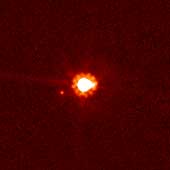Black holes are at the center of every galaxy. they also have massive gravitational pull. there are billions of block holes out there in space and each one has the power to create its own galaxy by sucking in debris and other space junk.over time this will create a galaxy. black holes are often refered to in science fiction because light and time have strange properties near them. black holes are very interesting and im going to type a few paragraphs about them.
Black holes were first proposed in the 18th century and they were named "black holes" by John Archibald who was an astronomer. the name has stuck and it even has become a common name in the scientific community. they are often the aftermath of a star dying and falling in on itself. they are "black" because they trap light in itself.
All the matter in a black hole is squeezed into a infantecimally (spelling :< ) small area of volume so no a black hole is not very big, but its weight is very vast. Its size is about a marble but that marble has the mass of about the mass of the earth. the black hole creates almost a stellar whirlwind as it sucks in all the stuff out there and that can be huge. Black holes are very very big and facinating and very real.
Monday, May 18, 2009
Monday, April 13, 2009
Sunspots....
Sunspots-Cool dark spots on the surface of the sun caused by strong magnetic fields.
How do they change?-when the magnetic fields change they change.
What is the purpose of the m diagram?-it tells where the solar maximums and the solar minimums are.
What is the sunspots cycle?-it is the cycle that they follow-max every 11 years.
Why do they matter to earth?-they change the weather patterns.
When will the next max be?-2010-2012.
How do we study them safely?-telescope
What telescopes work the best?-a telescope with a proper solar filter.
How do they change?-when the magnetic fields change they change.
What is the purpose of the m diagram?-it tells where the solar maximums and the solar minimums are.
What is the sunspots cycle?-it is the cycle that they follow-max every 11 years.
Why do they matter to earth?-they change the weather patterns.
When will the next max be?-2010-2012.
How do we study them safely?-telescope
What telescopes work the best?-a telescope with a proper solar filter.
Tuesday, April 7, 2009
Tycho Brahe...crazy man?...i think not

Tycho Brahe was born in 1546 and he contributed to the world of astronomy by devising a more precise and accurate telescope. he also brought new information to the community about the planets, especially mars. He found out that the orbit of mars was not round but an eclipse. He was an odd man, he reportedly dueled with swords over a dispute about math with is student. He died in 1601.
Phases of the moon

In the book the Scar it is a new moon. In the book Crown of Swords, I think its a waning gibbous moon. In the book Dreamscapes and Nightmares it has a waning crescent moon, and in the book Just a School Project it has a full moon. In the book Where the Wild Things Go it has a waxing gibbous. That concludes my blog...
Monday, April 6, 2009
Eris...it's in space
Friday, April 3, 2009
Keplar

The Keplar man was born in 1571 and died in 1630. He did a whole bunch of stuff like hypothesizing what physical forces caused the planet to move. He was heliocentric and we all know what that means by now. I don't think it was very fair seeings that he stole all the info from his teacher who died. O well
Galileo

Alright, to start, he was a really cool guys plus he was smart. He was heliocentric which meant(once again) he believed that the earth revolved around the sun. Some of his contributions to the astronomy world were, a brand new telescope =), sunspots and some moons of Jupiter. He was born in 1564 and died in 1642.
Subscribe to:
Posts (Atom)
